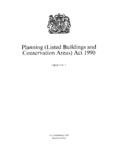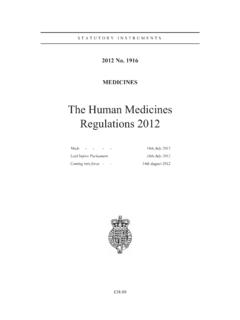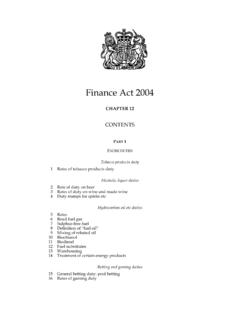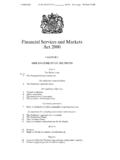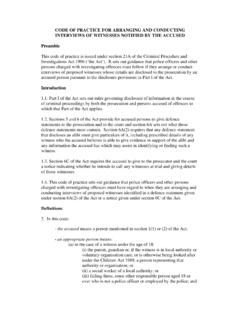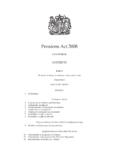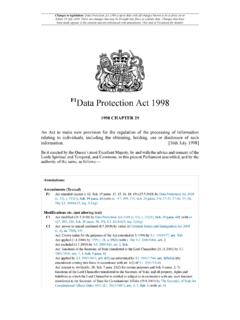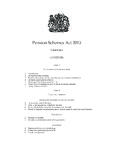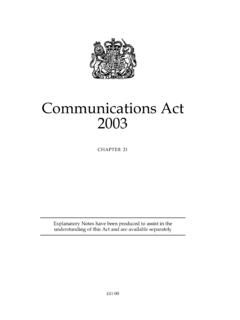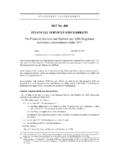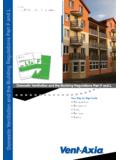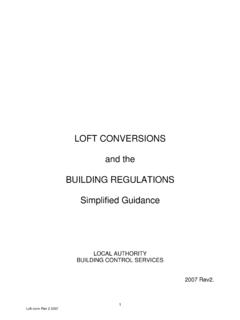Transcription of 2010 No. 2214 BUILDING AND BUILDINGS, …
1 STATUTORY INSTRUMENTS 2010 No. 2214 BUILDING AND BUILDINGS, ENGLAND AND WALES The BUILDING regulations 2010 Made - - - - 6th September 2010 Laid before Parliament 9th September 2010 Coming into force - - 1st October 2010 CONTENTS part 1 General 1. Citation and commencement 4 2. Interpretation 4 part 2 Control of BUILDING Work 3. Meaning of BUILDING work 6 4. Requirements relating to BUILDING work 7 5. Meaning of material change of use 8 6. Requirements relating to material change of use 8 7. Materials and workmanship 9 8. Limitation on requirements 9 9. Exempt buildings and work 9 10. Exemption of the Metropolitan Police Authority from procedural requirements 10 11. Power to dispense with or relax requirements 10 part 3 Notices, Plans and Certificates 12. Giving of a BUILDING notice or deposit of plans 10 13.
2 Particulars and plans where a BUILDING notice is given 11 14. Full plans 12 15. Consultation with sewerage undertaker 13 16. Notice of commencement and completion of certain stages of work 13 17. Completion certificates 14 18. Unauthorised BUILDING work 14 2 part 4 Supervision of BUILDING Work Otherwise than by Local Authorities 19. Supervision of BUILDING work otherwise than by local authorities 15 part 5 Self-certification Schemes 20. Provisions applicable to self-certification schemes 16 part 6 Energy Efficiency Requirements 21. Application of energy efficiency requirements 16 22. Requirements relating to a change to energy status 17 23. Requirements relating to thermal elements 17 24. Methodology of calculation and expression of energy performance 17 25. Minimum energy performance requirements for new buildings 18 26.
3 CO2 emission rates for new buildings 18 27. CO2 emission rate calculations 18 28. Consequential improvements to energy performance 18 29. Energy performance certificates 18 30. Energy assessors 20 31. Related party disclosures 20 32. Duty of care 20 33. Right to copy documents 21 34. Application of BUILDING regulations to educational buildings and buildings of statutory undertakers 21 35. Interpretation of part 6 21 part 7 Water Efficiency 36. Water efficiency of new dwellings 22 37. Wholesome water consumption calculation 22 part 8 Information to be Provided by the Person Carrying Out Work 38. Fire safety information 22 39. Information about ventilation 23 40. Information about use of fuel and power 23 part 9 Testing and Commissioning 41. Sound insulation testing 23 42.
4 Mechanical ventilation air flow rate testing 24 43. Pressure testing 24 44. Commissioning 25 3 part 10 Miscellaneous 45. Testing of BUILDING work 25 46. Sampling of material 25 47. Contravention of certain regulations not to be an offence 25 48. Electronic service of documents 25 49. Transitional provisions: interpretation 26 50. Transitional provisions: work already started before 1st October 26 51. Transitional provisions: work for which notification is not required 27 52. Transitional provisions: notice given or plans deposited before 1st October 2010 27 53. Transitional and saving provisions: earlier BUILDING regulations 27 54. Revocations and consequential amendments 28 SCHEDULE 1 Requirements 29 SCHEDULE 2 Exempt Buildings and Work 42 CLASS 1 42 CLASS 2 42 CLASS 3 42 CLASS 4 43 CLASS 5 43 CLASS 6 43 CLASS 7
5 43 SCHEDULE 3 Self-certification Schemes and Exemptions from Requirement to Give BUILDING Notice or Deposit Full Plans 45 SCHEDULE 4 Descriptions of Work where no BUILDING Notice or Deposit of Full Plans Required 49 SCHEDULE 5 Revocation of regulations 51 SCHEDULE 6 Consequential Amendments 52 The Secretary of State is a Minister designated(a) for the purposes of section 2(2) of the European Communities Act 1972(b) in relation to matters relating to the environment. In accordance with section 14(3) of the BUILDING Act 1984(c) he has consulted the BUILDING regulations Advisory Committee and such other bodies as appeared to him to be representative of the interests concerned. (a) 2008/301.
6 (b) 1972 (c) 1984 ; section 126 is cited for the definition of prescribed . Section 1 was amended by section 1 of the Sustainable and Secure Buildings Act 2004 ( ) and section 2A was inserted by section 4 of that Act; section 47(1) was amended by section 8 of that Act and 1996/1905; paragraph 4A of Schedule 1 was inserted by section 8 of that Act; paragraph 7 of Schedule 1 was amended by section 3 of that Act and by section 11 of the Climate Change and Sustainable Energy Act 2006 ( ); paragraph 8 of Schedule 1 was amended by section 3 of the Sustainable and Secure Buildings Act 2004 and by section 40 of the Flood and Water Management Act 2010 ( ); paragraph 11(1)(a) of Schedule 1 was amended by 1986/452. Certain functions of a Minister of the Crown under the BUILDING Act 1984 were transferred to the National Assembly for Wales constituted by the Government of Wales Act 1998 ( ) by article 2 of, and Schedule 1 to, the National Assembly for Wales (Transfer of Functions) Order 1999 ( 1999/672) as varied by article 4 of, and Schedule 3 to, the National Assembly for Wales (Transfer of Functions) Order 2000 ( 2000/253) and have been transferred to the Welsh Ministers by paragraph 30 of Schedule 11 to the Government of Wales Act 2006 ( ).
7 Subject to certain 4 The Secretary of State makes the following regulations in exercise of the powers conferred by section 2(2) of the European Communities Act 1972 and by sections 1(1), 2A, 3, 5, 8(2) and (6), 34, 35, 47(1) and 126 of, and paragraphs 1, 2, 3, 4, 4A, 7, 8, 9, 10 and 11 of Schedule 1 to, the BUILDING Act 1984: part 1 General Citation and commencement 1. These regulations may be cited as the BUILDING regulations 2010 and shall come into force on 1st October 2010. Interpretation 2. (1) In these regulations , unless the context otherwise requires the Act means the BUILDING Act 1984; amendment notice means a notice given under section 51A of the Act(a); BUILDING means any permanent or temporary BUILDING but not any other kind of structure or erection, and a reference to a BUILDING includes a reference to part of a BUILDING ; BUILDING notice means a notice given in accordance with regulations 12(2)(a) and 13; BUILDING work has the meaning given in regulation 3(1); change to a BUILDING s energy status means any change which results in a BUILDING becoming a BUILDING to which the energy efficiency requirements of these regulations apply, where previously it was not.
8 Controlled service or fitting means a service or fitting in relation to which part G, H, J, L or P of Schedule 1 imposes a requirement; day means any period of 24 hours commencing at midnight and excludes any Saturday, Sunday, Bank holiday or public holiday; dwelling includes a dwelling-house and a flat; dwelling-house does not include a flat or a BUILDING containing a flat; electrical installation means fixed electrical cables or fixed electrical equipment located on the consumer s side of the electricity supply meter; energy efficiency requirements means the requirements of regulations 23, 26, 28 and 29 and part L of Schedule 1; extra-low voltage means voltage not exceeding (a) in relation to alternating current, 50 volts between conductors and earth; or (b) in relation to direct current, 120 volts between conductors; final certificate means a certificate given under section 51 of the Act(b); fixed BUILDING services means any part of, or any controls associated with (a) fixed internal or external lighting systems, but does not include emergency escape lighting or specialist process lighting; or (b) fixed systems for heating, hot water, air conditioning or mechanical ventilation.
9 Exceptions and reservations, the remaining functions conferred on the Secretary of State by the BUILDING Act 1984 are transferred to the Welsh Ministers, as far as they are exercisable in relation to Wales, by the Welsh Ministers (Transfer of Functions) ( ) Order 2009 ( 2009/3019) with effect from 31st December 2011. (a) Section 51A was inserted by 1996/1905. (b) Section 51 was amended by 1996/1905. 5 flat means separate and self-contained premises constructed or adapted for use for residential purposes and forming part of a BUILDING from some other part of which it is divided horizontally; floor area means the aggregate area of every floor in a BUILDING or extension, calculated by reference to the finished internal faces of the walls enclosing the area, or if at any point there is no such wall, by reference to the outermost edge of the floor; full plans means plans deposited with a local authority for the purposes of section 16 of the Act(a) in accordance with regulations 12(2)(b) and 14.
10 Height means the height of the BUILDING measured from the mean level of the ground adjoining the outside of the external walls of the BUILDING to the level of half the vertical height of the roof of the BUILDING , or to the top of the walls or of the parapet, if any, whichever is the higher; independent access means, in relation to a part of a BUILDING (including any extension to that BUILDING ), a route of access to that part which does not require the user to pass through any other part of the BUILDING ; initial notice means a notice given under section 47 of the Act(b); institution means an institution (whether described as a hospital, home, school or other similar establishment) which is used as living accommodation for, or for the treatment, care or maintenance of persons (a) suffering from disabilities due to illness or old age or other physical or mental incapacity, or (b) under the age of five years, where such persons sleep on the premises; low voltage means voltage not exceeding (a) in relation to alternating current, 1000 volts between conductors or 600 volts between conductors and earth; or (b) in relation to direct current, 1500 volts between conductors or 900 volts between conductors and earth; material alteration has the meaning given in regulation 3(2); material change of use has the meaning given in regulation 5.
